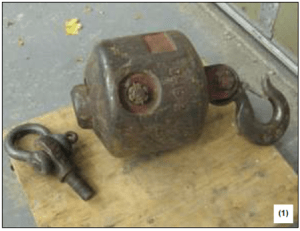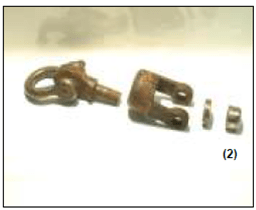Inspection of Overhaul Balls & Hook Blocks
Sometimes it can be easy to neglect to inspect some parts of your rigging hardware, especially when they rarely show external signs of wear. Case in point is inspection of overhaul balls and hook blocks. Frequent lubrication and quick visual checks on the exterior are simply not sufficient enough to mitigate the risks associated with these critical components. The Safety Code on Mobile Cranes CSA Z150-98 Section 4.3.5.2 states that a teardown inspection shall be performed at least every 5 years or as recommended by the manufacturer.
Recently, a customer came to us with an older style split ball (Picture 1) which had failed in service. Fortunately the load was suspended only inches off the ground when the swivel assembly inside the ball failed (Picture 2), dropping the load.


Upon inspection, the interior of the ball was found to be well lubricated. However, over many years of service, the threads on the steel lug had deteriorated to the point of becoming dull and rounded off. This general corrosion on the threads eventually led to failure under load. The retaining nut had been secured using a split pin, and when the threads on the shaft failed, the load was transferred to the pin which failed in shear. The broken face of the pin, still lodged in the threaded shaft as it pulled through the nut, wiped the threads off the inside diameter on its way out. Evidence of this was clearly visible on the inside face of the nut (Picture 3).

This is a text book case of why it’s so important to have tear down inspections performed on a regular basis. In the mid-90’s the Canadian Standards Association and the Ontario Ministry of Labour recommended changes to the standards the regulations. Threads in snut 3ervice like those on overhaul balls and block assemblies are particularly vulnerable to corrosion because of road salt, the exposed position of at the front of the crane, and the fine threads that trap moisture. After inspection, the assembly can be relubricated with molybdenum disulphite or another sacrificial corrosion lubricant.
It is also important to point out that use of the older style split ball is prohibited as per OHSA Regulation 213/91 Section 175 (2).




